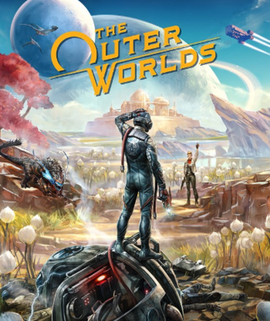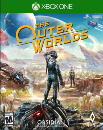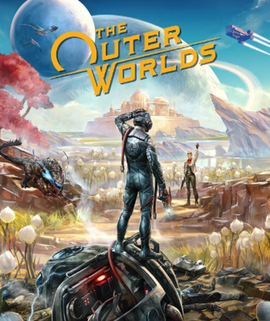
The Outer Worlds (PC) - Review
by Chinh Tran , posted on 04 December 2019 / 3,640 ViewsFor years Obsidian Entertainment worked behind shadows of giants like BioWare and Bethesda, developing sequels and spin-offs to established properties like Neverwinter Nights and Fallout. More recently, though, original titles like Pillars of Eternity prove they're capable of stepping out of the shadows to craft strong role playing experiences entirely of their own. Obsidian's The Outer Worlds continues this upward trend in many ways and comfortably sits near the top of Obsidian's output, but some setbacks in certain areas blemish the overall package.
Early on The Outer Worlds is fantastic. At the start of the game you're awoken from a frozen slumber by an enigmatic scientist named Phineas Welles. After a somewhat straightforward character creator, you're sent to a planet called Terra 2 in the Halcyon Cluster where - after a brief tutorial - you're tasked with becoming the new captain of a grounded spaceship; the aptly named The Unreliable. To repair your ship, you need to make a difficult decision: reroute power to either the town of Edgewater or to an offshoot settlement. Going in one direction results in the end of one settlement and the continuation of the other. It's decisions like these, along with their strong consequences, that make The Other Worlds shine.
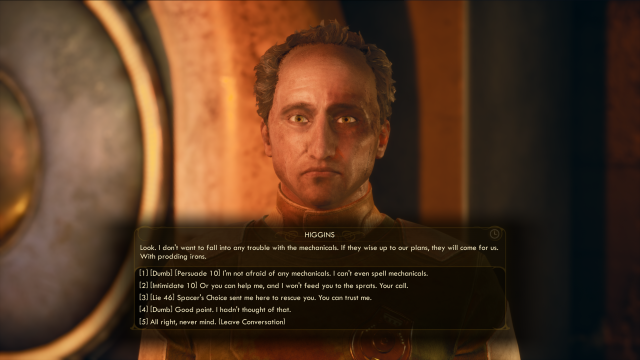
Players will face several key decisions throughout a single playthrough, the crux of which involve either siding with the Halcyon Company - a corporate entity that controls most of the Halcyon star system - or with Phineas Welles - the aforementioned scientist whose goal involves bringing about the end of Halcyon's hegemony of the Colony through a revolution. Thanks to the amount of choice and player freedom, every playthrough can be very different, providing a good amount of replayability. The story is pretty standard science fiction with a critique of capitalism, but the writing, dialogue choices, and characters elevate it.
Characters are well written, particularly Phineas Welles and your prospective party members. A standout is Parvarti, an engineer who you meet early on. Her companion quest involves building up her courage to ask someone out on a date. It also tasks you with finding special delicacies on different planets which she'll present to her date. Vicar Max is another interesting party member whose companion quest leads him on a path of truth and redemption. The companions are all memorable, believable, and stand out.
There are six companions in total and you can have up to two accompanying you at a time. Each can be equipped with weapons and armour as well and are given perks for you to choose from when they level up. Your decisions affect the outcome of their relationship to you too. Piss them off too much and they’re willing to part ways. While they accompany you, each give unique bonuses to various skills.
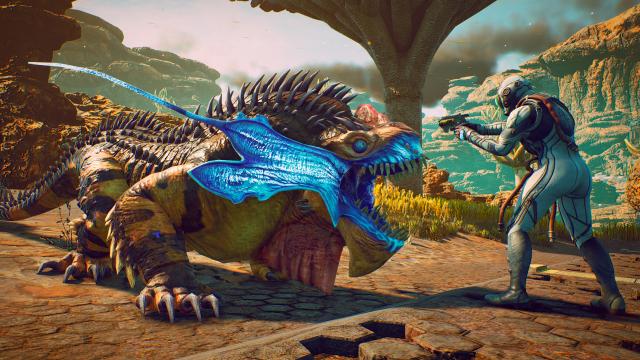
Skills in The Outer Worlds are initially bundled into different groups and increase together. For instance, placing one point into the Ranged group increases the skill of Handguns, Long Guns, and Heavy Weapons at the same time. When one of those skills in a group reaches 50, it can no longer be leveled up as a group, but rather independently, forcing you to spend points on each of those skills individually. Every level gives you 10 skill points to spend, along with a perk point that lets you choose a variety of bonuses. Equipment and party members can increase points as well. While this does give you a large degree of freedom and customization, the amount of points you get is too generous and, consequently, the game becomes easier the further you get; even too easy at times.
Veterans of the Fallout games will want to increase the difficulty to at least Hard. Normal is just too much of a cake walk outside of the early parts. Supernova difficulty is an option as well, but it introduces survival mechanics that aren’t found in the other modes. In it you have to eat, drink, and sleep to maintain optimal efficiency, and sleeping can only be done on The Unreliable. If companions die in Supernova mode, it's permanent. These extra challenges can be interesting initially but become tedious later on. Regardless, if you're looking for a challenge, Normal just won't be enough. By the end of my Normal playthrough I had never eaten any food, never ran out of bullets, and had almost 100 Adreno Syringes (used for healing).
Another reason why The Outer Worlds becomes unchallenging is the combat. While initially exciting and full of options, it's too easy to become unstoppable after a while. Enemies usually fight in groups but even the largest alien creatures prove unworthy opponents. I had the same gun for most of my first playthrough and, once I'd modified it with a scope and N-ray bullets, enemies could barely get close enough to me to be a threat. Your allies make it even easier. Each of them has an ability you can get them to use which assists in combat, but I rarely needed them on the default difficulty setting. I actually just used companions as meat shields and for the skill boosts more than anything else.
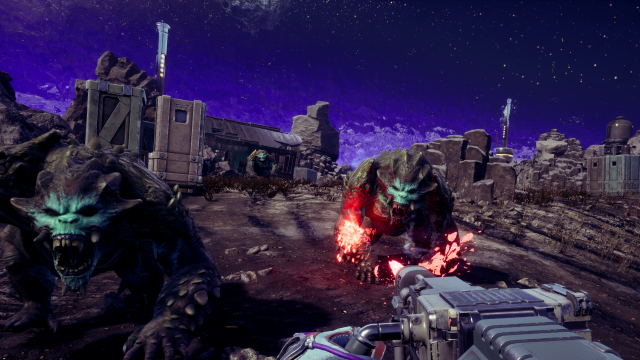
There are a lot of options to tackle enemies and all of them are viable. Although I focused on Long Guns, I always made sure I had a sidearm and melee weapon equipped just in case. There's a wide assortment of weapons ranging from rifles, pistols, shotguns, plasma guns, and different melee weapons. On top of that, weapons can be modified to suit your playstyle. Scopes make your weapon more suited for long range attacks, or magazines can be equipped with more ammo or elemental bullets like lightning. Increasing different skills opens up even more options. You can learn to be more agile with extra jumps, do more powerful melee attacks, and increase your sneak attack damage. With all these options it's a shame combat rarely requires you to do more than just shoot enemies from afar before they can even get close to you.
Another noteworthy mechanic of combat is Tactical Time Dilation, which is essentially The Outer Worlds' version of Fallout's VATS system, allowing you to lineup shots more easily and expose enemy weaknesses. Moving around and firing your weapon drains the meter more quickly. It's certainly a useful skill to have and watching your enemies crumple in slow motion is oddly satisfying.
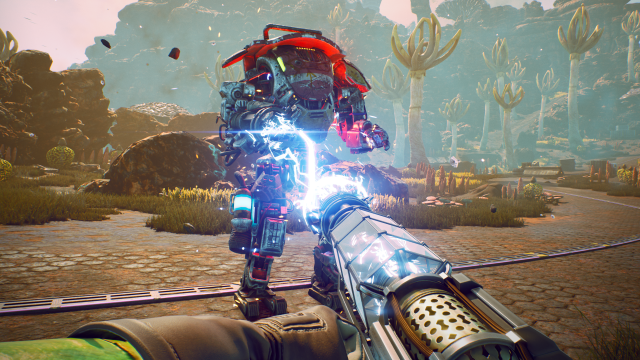
Enemies themselves come with a lot of variety. You'll deal with different types of humanoids, mechanical guards, and alien creatures through your journey across the Halcyon Colonies. Humanoids are generally pretty straightforward and range from close quarter combatants to snipers. Mechanical enemies come in the form of combat drones, a variety of sentries, and large scrap mechanicals who can launch themselves in the air and slam the ground around you. By far the most interesting types of enemies are the different alien creatures. You’ll fight giant gorilla-like creatures in the Primals, dinosaur-inspired Raptidons, and giant insects such as the Mantisaurs who would be right at home in Starship Troopers. On top of that, many of these enemies have variant versions which force you to deal with different sets of resistances and armours.
The enemies, like most of The Outer Worlds, come to life thanks to impressive graphics. The drab post-apocalypse of Fallout: New Vegas is gone, replaced by bright and vibrant graphics. Characters animate pretty well but the standout is the environments. Although the actual maps are mostly small, each planet looks unique. Alien landscapes don't look empty like in other games but rather filled with unique flora and fauna. Lush forests, desolate badlands, and sweltering swamps are only some of the environments you'll visit. I was particularly impressed by simply looking up at the sky in certain maps. Gargantuan planets can sometimes appear when you're on the moon, which further enhances the experience of being in another universe.
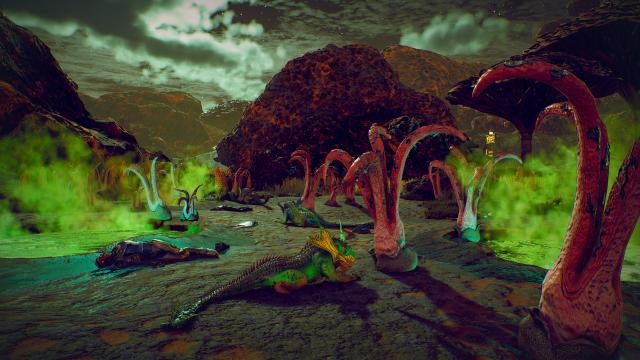
Not everything is strong on the presentation front though. Stuttering occurred for me frequently at the start of a loaded map. This goes away eventually but is still worth noting. Audio design is solid overall but nothing really stood out. The voice acting is sufficient, with major characters and companions leading the way. Weapon sounds are also good, with a few unique ones mixed in. Outside of the main theme, though, the music is not very memorable. These deficiencies don't detract from the overall experience, especially if it's not something you pay much attention to.
Although not without some drawbacks, The Outer Worlds is one of Obsidian's better efforts. The strong dedication to player agency, impressive replayability, multitude of variety, and masterful implementation of RPG mechanics results in a title sci-fi RPG fans should not miss. Sure, the lack of challenge later on in Normal mode can be a let down, but it is at least somewhat mitigated by optional higher difficulty levels. Even though the audio design leaves a lot to be desired, the presentation, aside from some stuttering, results in a strong feeling of a different universe. As a result of all this, Obsidian Entertainment has a very promising new IP on its hands and a stronger sequel may very well help them to not only step out of the shadows, but rather into the spotlight.
VGChartz Verdict
7
Good
This review is based on a digital copy of The Outer Worlds for the PC, provided by the publisher.
More Articles
A nice review and it replicates some of my feelings on it. I enjoyed my time with the game during my playthrough but sadly that is my issue 'playthrough', singular. The story felt like it just ended and having done most of the side missions it felt like there was little else to do except play through again on a harder difficulty (or as a idiot character). I guess that is how it's meant to be done.
























